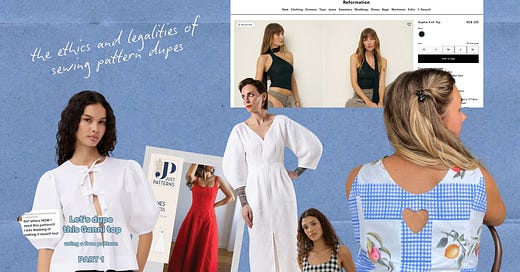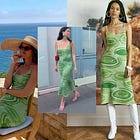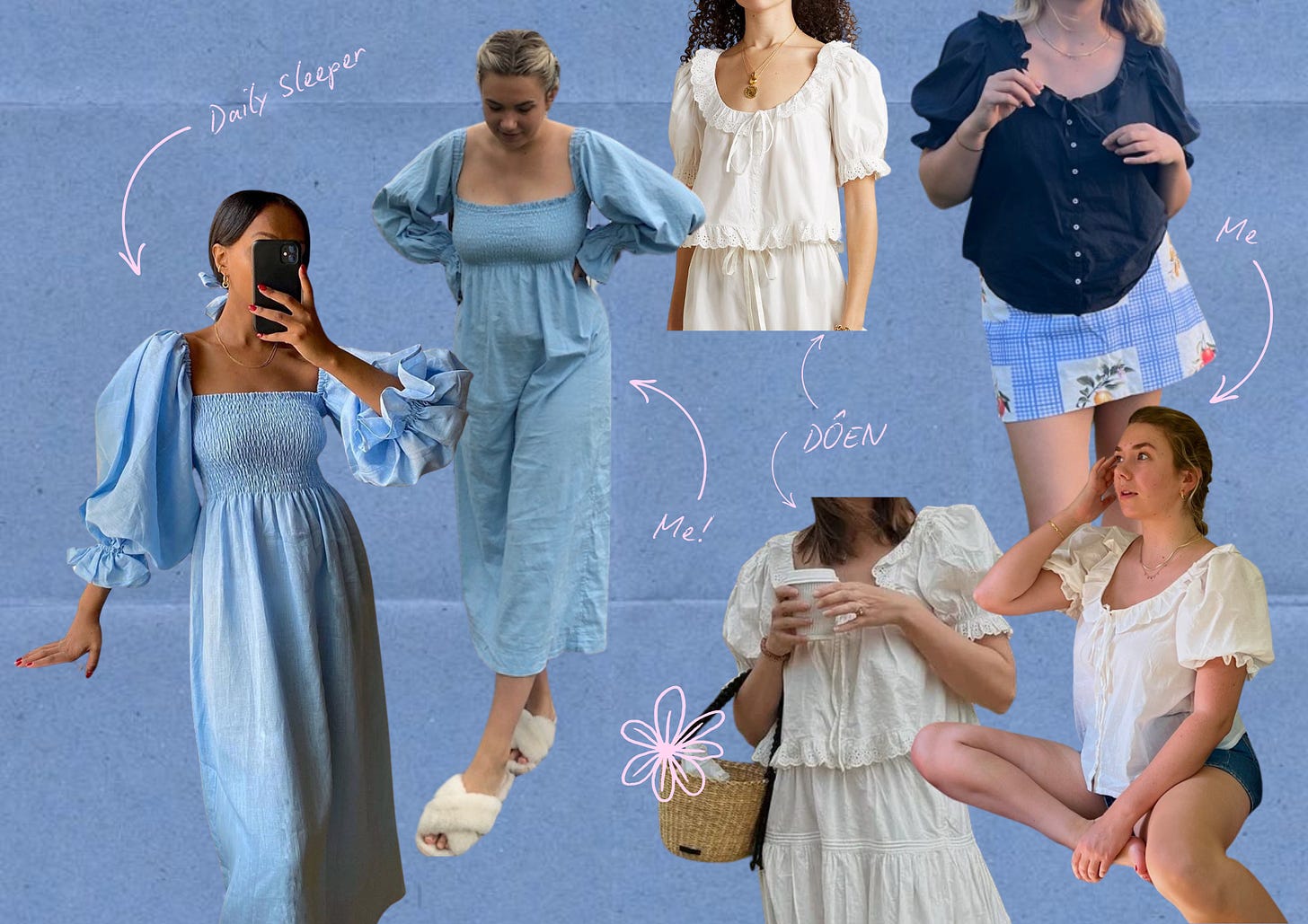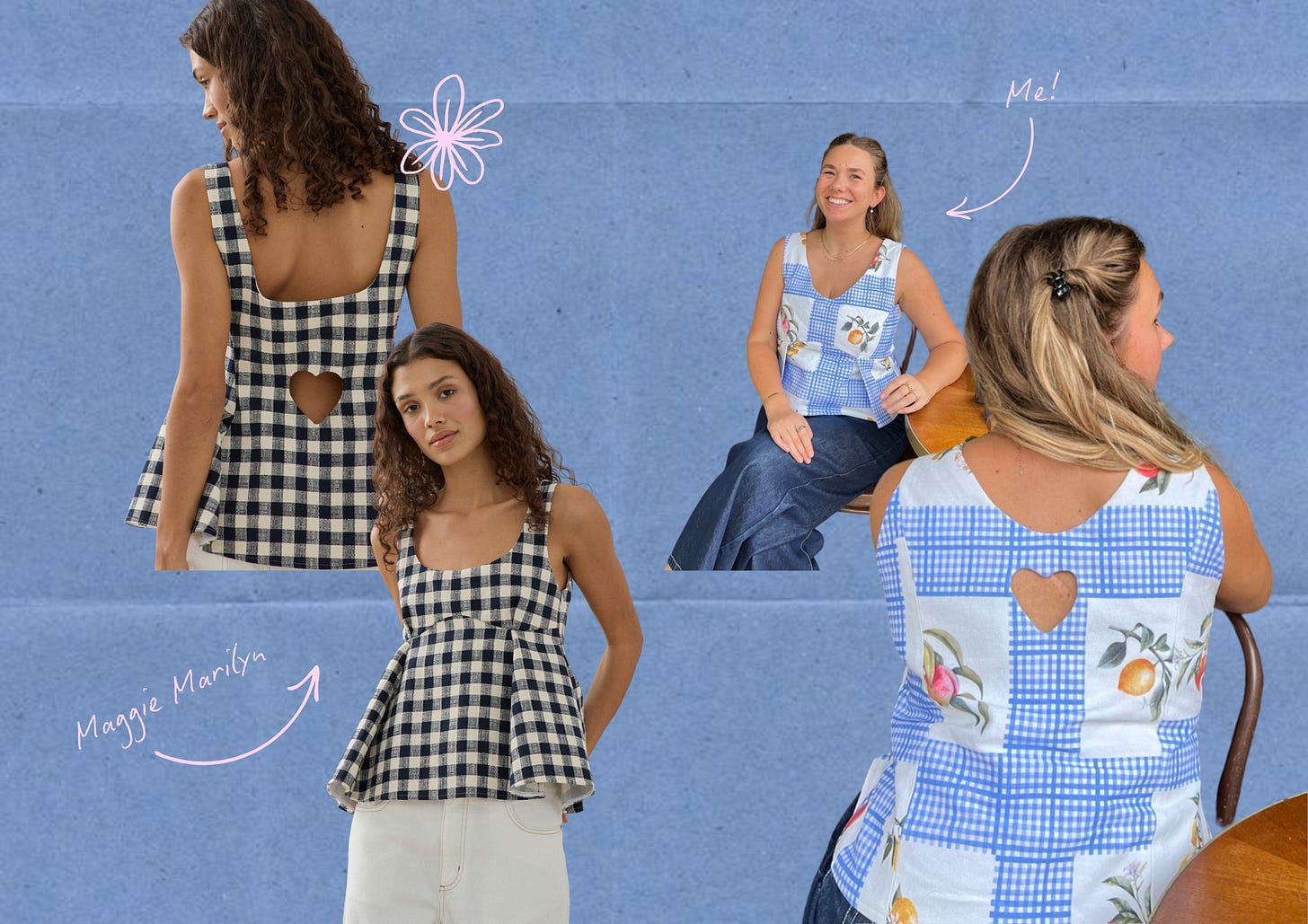How ethical is it to make and buy sewing patterns based on ready-to-wear clothing? Are sewing ‘dupes’ any better than SHEIN ripping off a small designer? Or is it a completely different issue and I’m overthinking all of this?
These are all questions I’ve been grappling with for a while now. This topic has been on my mind ever since I saw the controversy surrounding the Closet Core Patterns Jo Dress. It was alleged that this pattern copied the design of a Mara Hoffman dress and there was a minor online furore as people commented either supporting or calling out Closet Core.

Then I noticed a wave of sewists posting tutorials on how to recreate the viral Ganni tie-front top. And before I knew it, I was seeing sewing patterns everywhere that were duping ready-to-wear designs.
Last week, I wrote about dupes in ready-to-wear fashion. I concluded that they are problematic largely because they fuel overconsumption. But do I think the same when it comes to sewing?
On ready-to-wear dupes:
The issue isn’t that people want stylish, well-designed clothes at an accessible price. It’s that dupes often reinforce the worst aspects of modern fashion: disposability, excessive consumption and the erasure of meaningful design work. Suppose we truly want fashion to be more accessible. In that case, the solution isn’t endless knock-offs — it’s valuing what we buy, supporting ethical production, and redefining what it means to ‘deserve’ something.
Sewing dupes — they’re everywhere!
In fashion, a ‘dupe’ (short for duplicate) refers to a product designed to closely resemble a more expensive or well-known item. But a dupe does not copy logos, so it’s not an outright counterfeit.
In the sewing world, dupes take the form of sewing patterns or DIY tutorials that allow people to recreate popular ready-to-wear garments or luxury looks at home.
I’ve seen many patterns that can be directly compared to a dress, top or pair of pants you could buy in a shop. I’ve also dabbled in dupes myself. Recently I made a top directly inspired by the sold-out DÔEN lazuli blouse, and when I first started sewing I made a shirred dress that duped the Daily Sleeper Atlanta dress.
Some creators have perfected the art of finding sewing patterns that closely resemble ready-to-wear looks. I really enjoy Pauline’s (@sewuthinkucan) sporadic sharing of ‘sew the look’ sewing pattern recommendations, Jade's (@jaderselise) ‘there’s a pattern for that’ series where she breaks down how to recreate high-end clothing using sewing patterns and a few minor hacks, and the ‘dupe this look’ blogs posted on ChCh Sews.
But is it illegal?
Like in ready-to-wear fashion, it’s nearly impossible to enforce copyright or trademark claims on sewing dupes. This means that sewing pattern companies are unlikely to face legal trouble for producing similar styles to ready-to-wear clothing.
Of course, if one pattern business outright steals another’s pattern, instructions and promotional material — then there might be a case depending on the jurisdiction. But the sewing pattern dupes themselves aren’t illegal, and the home sewing industry isn’t exactly a threat to the ready-to-wear fashion market so it’s unlikely a case will ever be brought to court.
So if it’s not illegal, the next question is — are sewing dupes ethical?
My thoughts are split into three categories:
Individuals making dupes for themselves or sharing free tutorials on how to recreate expensive clothes for less.
Pattern makers selling patterns that directly (or very closely) resemble ready-to-wear designs for profit.
Ready-to-wear copying pattern makers.
Category 1 — totally fine!
Firstly, sharing is caring! The sharing of knowledge is a fundamental part of the sewing community.
Secondly, no one is profiting if you remake a garment you already have and love or if you follow a free dupe tutorial. Not profiting from someone else’s design is at the core of why I have no qualms with category one.
People DIY-ing dupes at home or following a free tutorial were probably never going to buy the original — so no one’s business is being undercut. And if they did want to invest in the original, they still could! Plus, let’s not forget that sewing requires skill, time and an upfront investment in tools and materials. This isn’t an impossible barrier to overcome, but it’s not like sewing is a cost-free alternative to shopping.

Category 2 — slightly complicated but still okay?
When it comes to pattern companies selling designs that closely mimic ready-to-wear garments, my stance is a little more complicated.
Drafting, grading, writing instructions and marketing a pattern all require significant labour. It’s not a simple case of seeing a design, copying and releasing it for sale — there’s real work involved.
But if the style was originally designed by someone else, surely that shows a lack of creative spirit and raises ethical concerns?
Category 3 - it’s a no from me…
Is Anything Truly Original?
I’ve often wrestled with the question: is it ethical to sew a dupe of a garment I admire? Am I stealing the idea for that design? By buying a pattern and making the item myself, am I cutting the original designer out of the process? What I’ve come to realise is this…
There are no new ideas!
Unless a design includes a completely new and innovative feature (and let’s be honest, how often does that happen??), all fashion is a reference to something that came before.
I once watched an interesting video by a vintage shop owner who explained that major fashion houses were sending interns to her store to purchase old garments, take them apart and create patterns from them.
That’s a very obvious example of copying in ready-to-wear. However, it highlights the point that there are very few unique ways to draft a sleeve, pants or shirt block.
But just because it happens — does that make it okay? My first instinct is that copying shows a lack of creativity. Further examination of my own sewing practices though, makes me question this stance. I’ve copied plenty of clothes as I learnt to sew. As I was doing that, I was definitely still flexing my creative muscles. Firstly I was being creatively inspired by what I saw around me, and then I needed to decipher how a garment was put together, choose the fabric and alter the shape to fit my body.
Ultimately, sewing is less about copying and more about referencing. This is because everyone puts their own spin on their makes. Whether it’s the fabric choice, moving a dart or adding length — each creative decision made by the pattern maker or the sewist makes each garment unique.
And referencing is a very normal part of fashion! When designers reference, they are acknowledging a style’s origins but putting their spin on it to make it something new. You’ll see this on runways, in stores and, of course, in patternmaking. When Anna Allen released the Persephone Pants pattern, she wrote about how they were influenced by 1940s sailor trousers. Another pattern maker, Just Patterns, has been very open about using the ‘new in’ sections at luxury retailers for inspiration.
IMO: Best practice is to follow Anna Allen and Just Pattern’s example. By acknowledging their references and making tweaks to update (not copy) designs, they are infusing creativity into a craft that, ultimately, only has a set number of ways to sew a sleeve!

Why sewing pattern dupes are kind of okay…
But referencing fashion history, or another designer’s style, does not equal a dupe. So why do I feel kind of okay about sewing patterns that dupe ready-to-wear?
The number of people who sew is relatively small.
The percentage of people who sew will never overtake the vast number of consumers purchasing ready-to-wear clothing. A sewing pattern dupe of a Zara or Prada design will not impact their yearly profits.
However, it’s potentially a different story when it comes to small designers. This argument surfaced during the Closet Core/Mara Hoffman debate (even though you could no longer buy the Mara Hoffman dress). Shoppers who sew are more likely to support slow-fashion brands. So, a sewing pattern dupe of a small business’ designs might redirect potential sales to the pattern maker instead of the original designer. As these businesses try to do good and stay afloat, this potential stealing of their profits would definitely be a problem!
But in my experience, I can support my favourite slow fashion brands and make similar items myself. For example, I recently made a top inspired by the Maggie Marilyn Heart Wide Open top, but I also own a Maggie Marilyn blazer, puffer and hoodie. People can hold multiple truths!
There’s a precedent for this.
In the early 2000s, Vogue Patterns sold exact copies of Donna Karan’s runway designs, made available to home sewists with the designer’s permission. Vogue has a long history of licensing high-fashion looks for the home sewing market. Even brands like Ruby (a New Zealand-based label) have entered the sewing game, selling patterns from their Liam collection under Liam Patterns.
These examples are all officially licensed copies, which is different to selling unlicensed dupes. However, looking at the Big 4 sewing patterns you’ll see that there is a strong historical precedent for sewing dupes. Yes, these pattern companies have built their businesses on selling licensed designer patterns — but they’ve also sold many patterns that have a striking (and unauthorised) resemblance to designer clothes.
Sewing patterns offer greater size inclusivity than ready-to-wear.
Ready-to-wear sizing is often restrictive. Sewing patterns — especially from modern indie brands — tend to be far more size-inclusive, making fashion more accessible to those who wouldn’t otherwise be able to buy a particular look off the rack.
The environmental and social issues tied to ready-to-wear dupes don’t apply to sewing.
Sewing is an inherently slow fashion practice. You can’t sew at the same rate you can go into a store and buy clothes. The relentless churn of overconsumption plaguing fast fashion doesn’t exist in my sewing world.
Plus, the time it takes to make something means I cherish my handmade items for longer and I have the skills to repair my clothes — all of which prolongs a garment’s lifespan and keeps it from polluting our landfills.
But what if a ready-to-wear company dupes a pattern maker?
With all of that said, if a large ready-to-wear brand or luxury designer copied an independent pattern maker’s design, I’d view the situation differently.
The financial and power imbalance between a small pattern business and a global fashion company is significant. If you have a team of designers, surely you can come up with something original? But then we return to my earlier point — is anything truly original?
When Reformation allegedly copied Sewing with Solana’s scarf top my eyebrows were definitely raised. But I’m not going to cancel Reformation’s whole business. I’ll just avoid buying that top, and invest my time and money into the pattern instead. So perhaps I’m a hypocrite! One attitude for sewing companies and another for ready-to-wear.
Final thoughts
I understand why some people take issue with sewing patterns that closely resemble existing designs — especially when the original is from a small, slow fashion brand. However, my concerns about overconsumption with ready-to-wear dupes don’t translate to sewing. It’s highly unlikely that home sewists are significantly undercutting the profits of ready-to-wear brands. And ultimately, the idea of originality in fashion is largely a myth.
I’m currently designing my own sewing patterns. I’m drawing inspiration from a variety of sources, including clothes I see in the world. When I finalise my designs, I won’t be directly copying any particular piece, but I also can’t claim that they’ll be entirely unique. What will be unique, however, is my approach — my instructions, sew-along tutorials and the way I present my patterns. That thoughtfulness and intentionality is what distinguishes sewing patterns from fast fashion dupes.
At the end of the day, sewing exists outside of the relentless churn of the fashion industry. While the ethics of pattern dupes might not have a clear-cut answer, what’s undeniable is that home sewing encourages people to engage more deeply with their clothing — through learning, making, and appreciating the craft behind every stitch.
Unlike fast fashion dupes, which fuel overconsumption, sewing is an act of care and creativity. So rather than asking whether sewing pattern dupes are ethical, perhaps the better question is: how do we encourage more people to learn to sew?











I think about this all the time! Almost everything I sew is based on something that's for sale because I either:
1. don't want to support the fast fashion brand
2. can't afford it
3. want to learn/figure out how it's made
This was so thorough! Sewing a dupe, especially when you make your own pattern, is a great way to learn about drafting, practice skills and build confidence. I also think it’s a little act of rebellion.